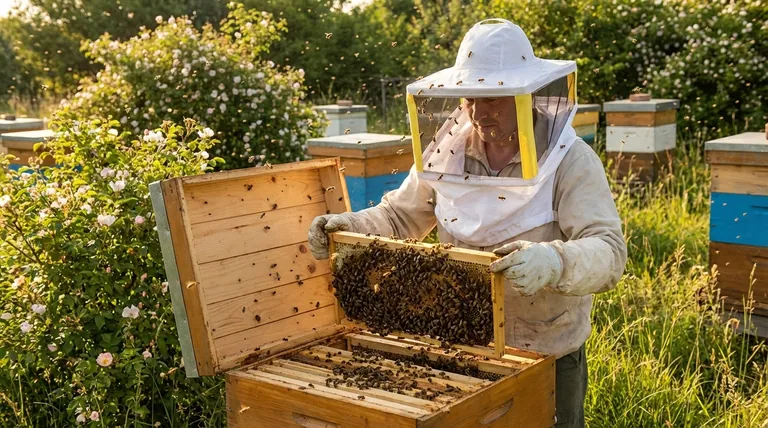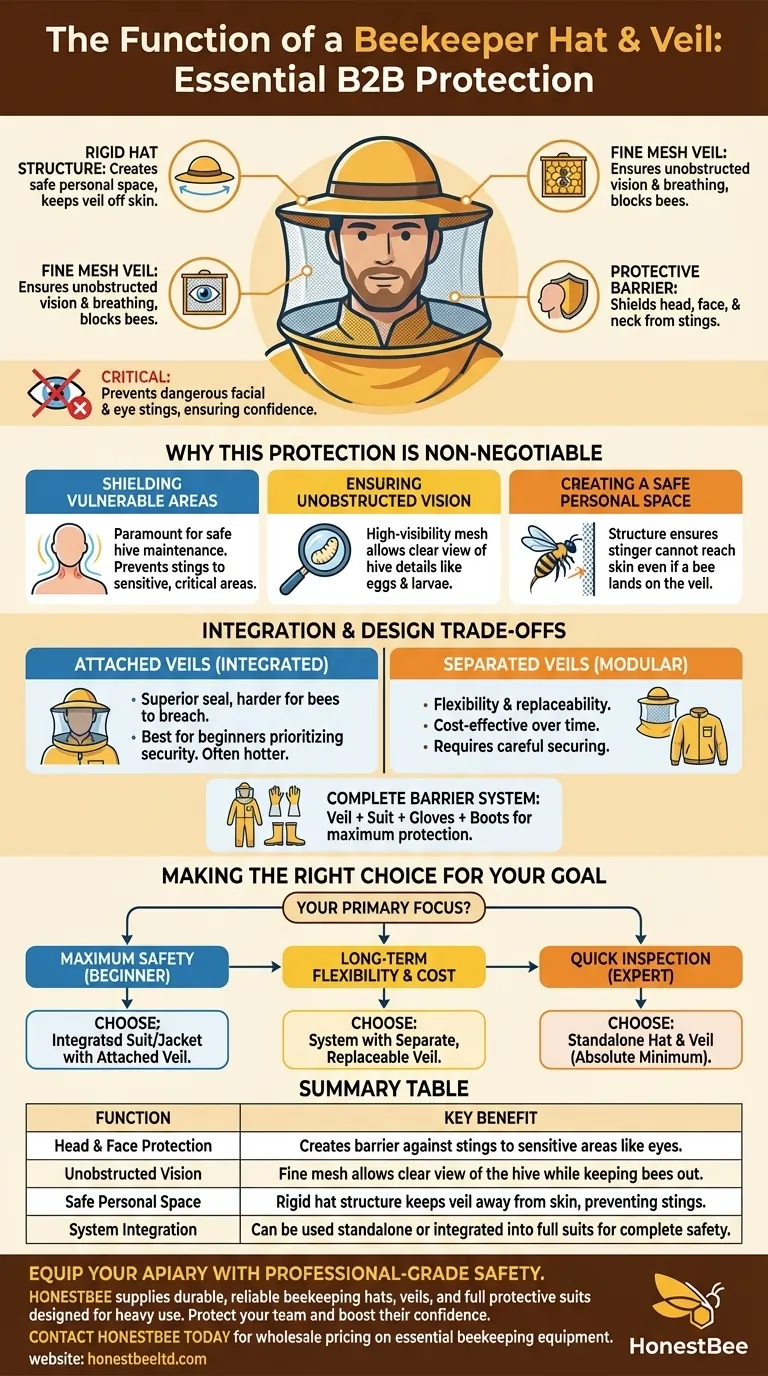At its core, the function of a beekeeper hat and veil is to provide a critical protective barrier for your head, face, and neck against bee stings. The hat offers structure and keeps the veil away from your skin, while the fine mesh veil ensures you can see and breathe clearly while preventing even angry bees from making contact.
The hat and veil are arguably the single most important piece of protective equipment. While stings on the body are painful, stings to the face—especially the eyes—are uniquely dangerous and can quickly undermine a beekeeper's confidence and safety.

Why This Protection is Non-Negotiable
A beekeeper's work requires calm, steady hands and focused attention, often while surrounded by thousands of defensive insects. The hat and veil are designed to make this possible.
Shielding Your Most Vulnerable Area
The primary goal is to prevent stings to the head and neck. These areas are not only sensitive but also critical for your ability to see, breathe, and react. Protecting them is paramount for safe hive maintenance.
Ensuring Unobstructed Vision
The veil is constructed from a high-visibility, durable mesh. This material is fine enough to block insects but transparent enough to allow for a clear view of the hive, including tiny eggs and larvae.
Creating a Safe Personal Space
The rigid structure of the hat is designed to keep the mesh veil away from your face. This space ensures that even if a bee lands on the veil, its stinger cannot reach your skin.
How the Veil Fits into a Protective System
While essential, the hat and veil are just one component of a beekeeper's protective wardrobe. How they integrate with other gear determines the overall level of safety.
The Absolute Minimum
Even the most experienced beekeepers consider a veil the minimum necessary protection for any hive work. It is the one piece of gear that should never be omitted.
Integrated Jackets and Suits
For enhanced protection, veils are often built directly into beekeeping jackets or full-body suits. This design creates a secure, sealed connection that leaves no gaps for bees to crawl into, which is ideal for beginners.
A Complete Barrier
When combined with thick gloves, heavy-duty boots, and a full suit, the veil completes a system that provides comprehensive protection from head to toe. This allows a beekeeper to handle even the most aggressive colonies with confidence.
Understanding the Trade-offs in Design
Not all veils are created equal. The primary choice comes down to whether the veil is permanently attached to a jacket or is a separate component.
Attached Veils: The Beginner's Choice
Veils that are zipped directly onto a jacket or suit offer superior protection. They create a perfect seal that is much harder for a bee to breach, providing peace of mind for those new to the craft.
Separated Veils: Flexibility and Replaceability
A separate hat and veil combination offers more versatility. If the mesh veil becomes torn or damaged, it can be replaced without having to buy a whole new jacket. This modularity can be more cost-effective over time.
Comfort vs. Security
As with all protective gear, there is a trade-off. A full suit with an integrated veil offers maximum security but can be hotter and more cumbersome. New beekeepers are almost always advised to prioritize security over comfort until they gain experience.
Making the Right Choice for Your Goal
Selecting the right equipment is crucial for a safe and enjoyable beekeeping experience. Your level of experience should guide your decision.
- If your primary focus is maximum safety as a beginner: Choose a full suit or jacket with an attached, integrated veil to eliminate any potential gaps.
- If your primary focus is long-term flexibility and cost: A system with a separate, replaceable veil may be a better investment.
- If your primary focus is a quick, minimal inspection (for experts): A standalone hat and veil is the absolute minimum, but only recommended if you are highly confident in reading bee behavior.
Investing in quality protective gear, starting with the veil, is the first step toward building a successful and rewarding relationship with your bees.
Summary Table:
| Function | Key Benefit |
|---|---|
| Head & Face Protection | Creates a barrier against bee stings to sensitive areas like eyes. |
| Unobstructed Vision | Fine mesh allows clear view of the hive while keeping bees out. |
| Safe Personal Space | Rigid hat structure keeps veil away from skin, preventing stings. |
| System Integration | Can be used standalone or integrated into full suits for complete safety. |
Equip your apiary with professional-grade safety. Whether you're a commercial beekeeper or a distributor, HONESTBEE supplies durable, reliable beekeeping hats, veils, and full protective suits designed for heavy use. Protect your team and boost their confidence during hive inspections. Contact HONESTBEE today for wholesale pricing on essential beekeeping equipment.
Visual Guide

Related Products
- Cotton Folding Square Beekeeping Hat and Veil with Removable Mesh Bee-Proof Design
- Ventilated Adult Beekeeping Helmet Hat for Beekeepers
- Wholesales Dadant Size Wooden Bee Hives for Beekeeping
- Professional Insulated Plastic Bee Hives
- Yellow Plastic Bucket Pail Perch for Beekeeping
People Also Ask
- What types of protective veils are available for beekeeping? Choose the Best for Your Safety & Comfort
- What are the different types of beekeeping veils? Choose the Right Protection for Your Apiary
- How can I keep ants out of my honey? A Simple, Permanent Solution
- What are the key features of a beekeeping hat and veil? Choose the Right Protection for Your Apiary
- Which type of bee veil offers the best protection? Maximize Safety with Proper Space and Design



















